Your home may be well-equipped with safety essentials like smoke alarms and fire extinguishers, but welcoming a new baby into your life will raise concerns about new hazards. To make sure you’re fully prepared before your new baby arrives, check out these simple ways to babyproof your home.
1. Make a Checklist to Babyproof Your Home
To prepare for all stages of your little one’s mobility and curiosity, make a checklist of ways to babyproof your home. Your list will be a reference so you won’t forget important babyproofing steps. Order the list chronologically, with newborn and infant-geared tips listed before those that apply to toddlers. Add dates as deadlines so you’ll know when to complete each task.
2. Set Up a Safe Sleeping Space
Your primary focus when babyproofing for your newborn should be to create a safe sleeping space. Keep the crib away from curtains or blinds. Add a firm mattress that fits snugly. Don’t use pillows, bumpers, or toys in the crib.
Keep an eye out in the nursery for items within easy reach that could be dangerous. If you choose to have your baby sleep next to your bed in a bassinet, take the same steps in your own room. Critical items to watch for include electrical cords and cords on window blinds.
3. Install Cabinet Locks and Corner Guards
Once your baby becomes mobile, babyproof for a toddler on the move. Relocate electrical cords that may be tripping hazards. Make sure that furniture is safe for exploring toddlers. Add padding to the corners of coffee tables and install locks on cabinets, drawers, and the toilet.
4. Clean Out Chemicals to Babyproof Your Home
Babyproofing locks will help keep your baby out of cabinets and drawers, but don’t rely on one, single safety measure. Make sure that any dangerous substances such as chemical cleaners and medications are stored overhead and securely out of reach.
5. Relocate or Secure Heavy Items
When babyproofing your home, prioritize heavy items that can fall and cause injury. Use furniture straps to secure large pieces of furniture like TVs, armoires, or stereo equipment. Anchor furniture to the wall to prevent your baby from tipping it over as they try to stand up.
Prepare by Babyproofing Ahead of Time
So that you’re well-prepared when your baby arrives, write out a list of childproofing tasks and order them chronologically so that you’re ready to adapt as your child grows.
Items to include on your childproofing checklist include removing dangerous items from around the crib, safely storing chemicals, and childproofing your furniture. Make furniture safer for your baby by padding the corners, installing locks on cabinet doors, and anchoring heavy pieces in place.
Rhode Island Real Estate Inspection Services offers home inspections to all of Rhode Island. Contact us to schedule an appointment.

